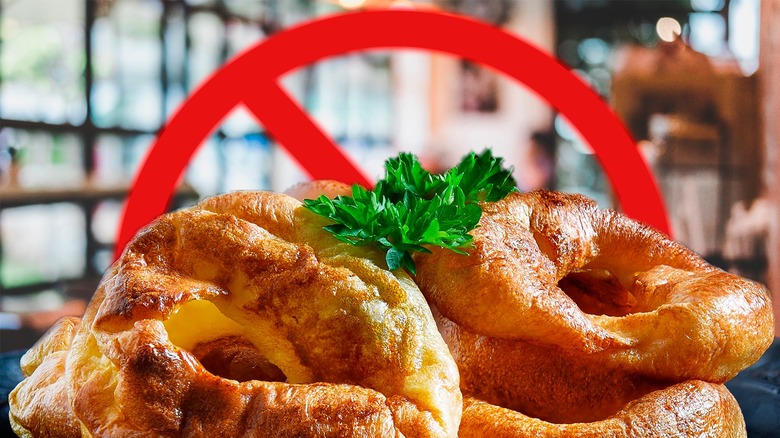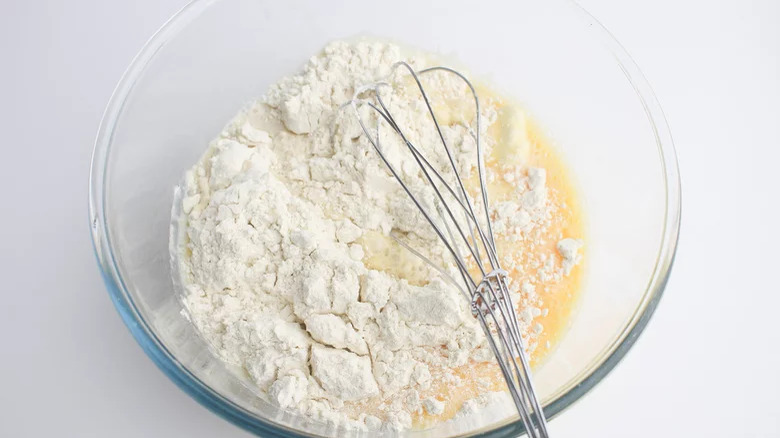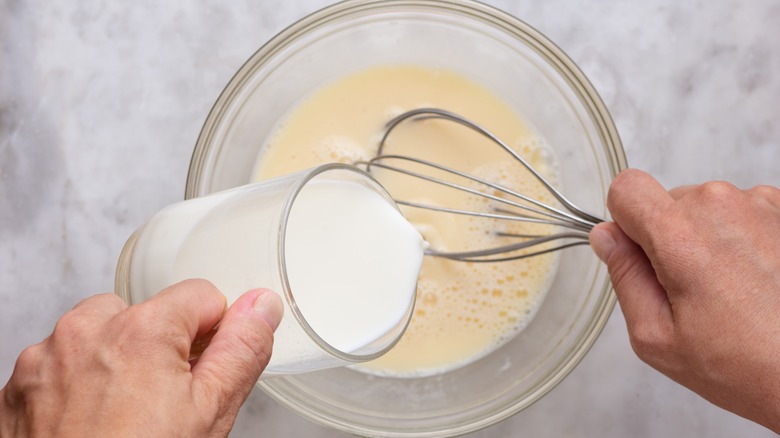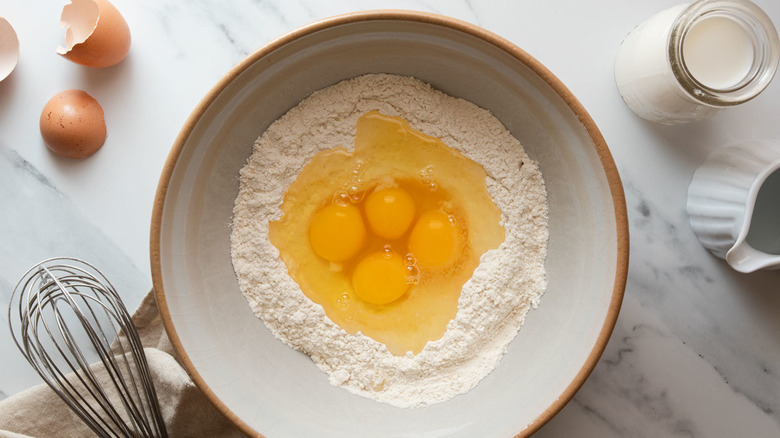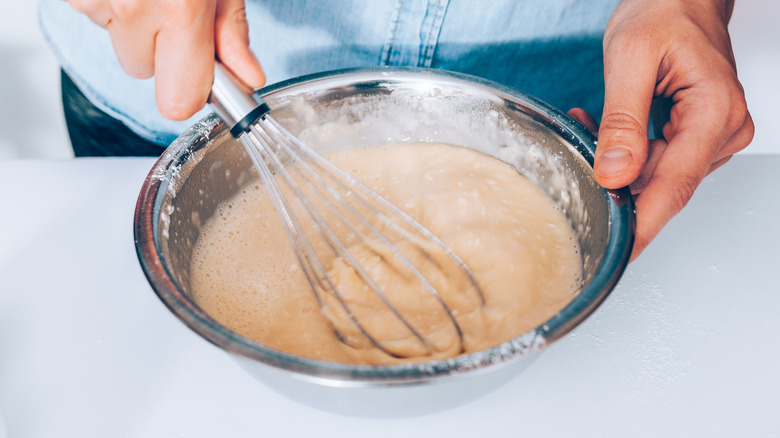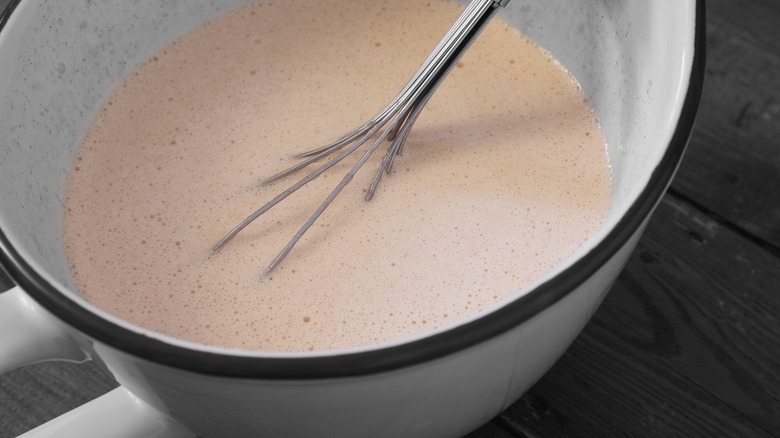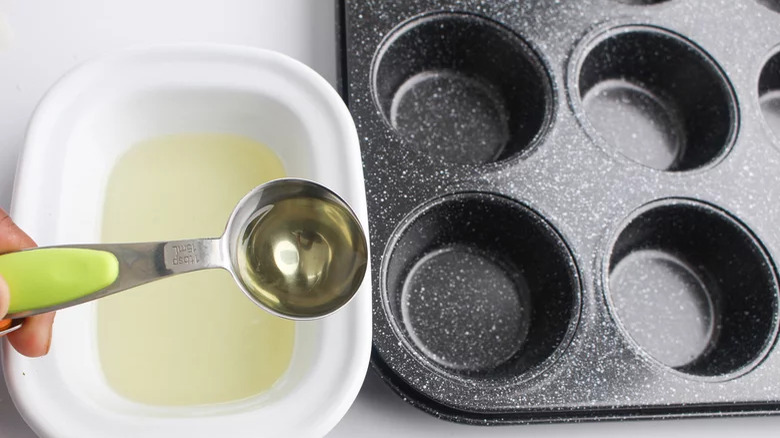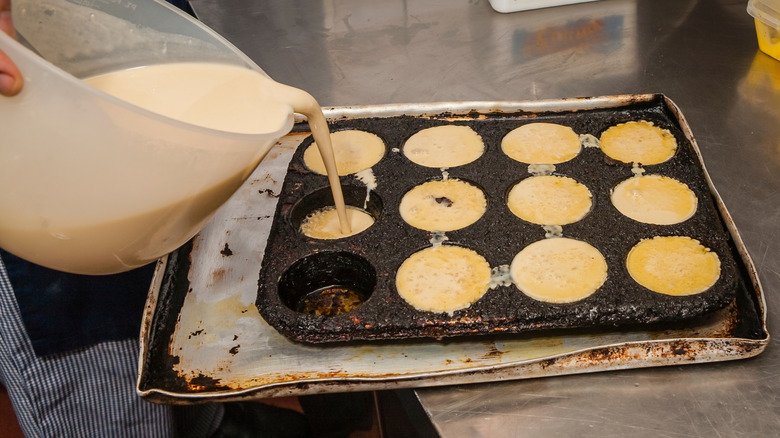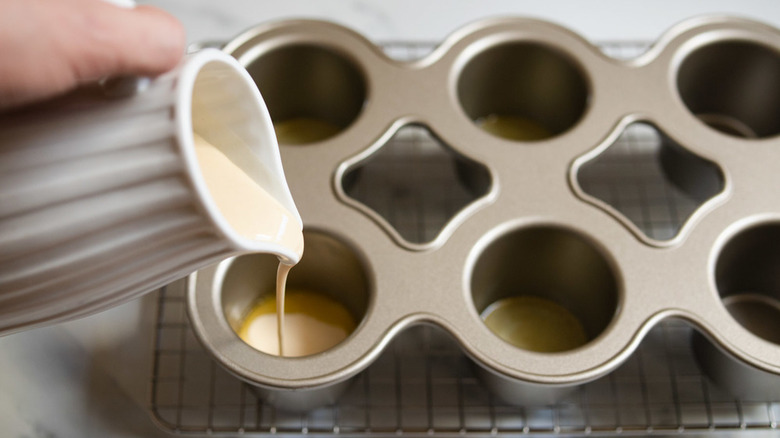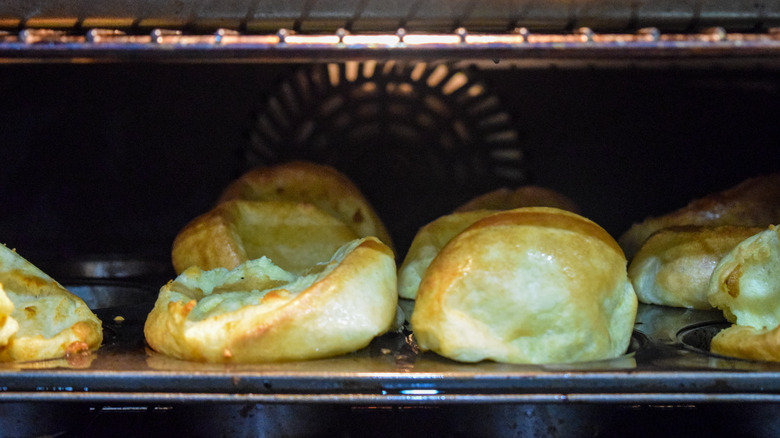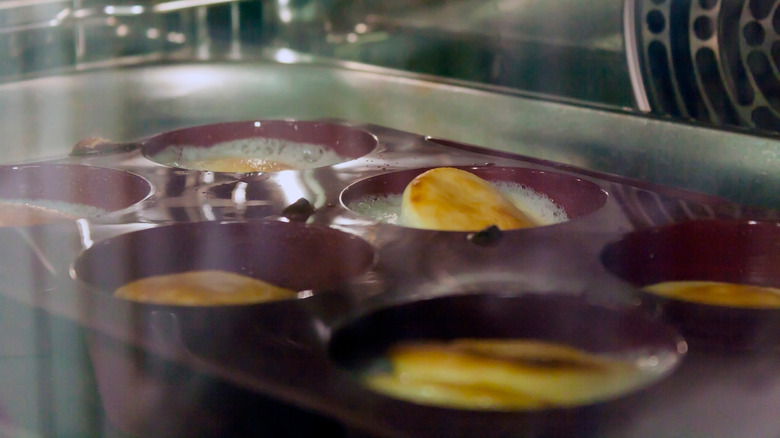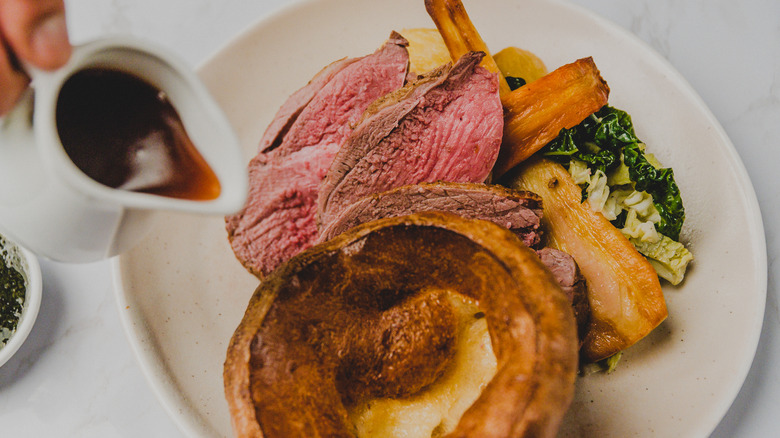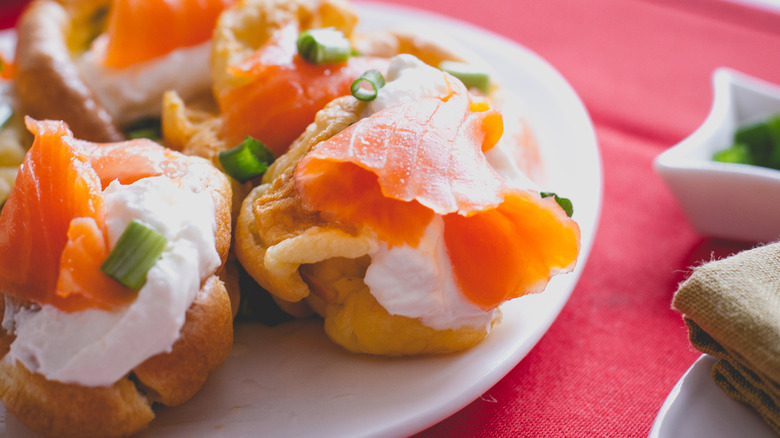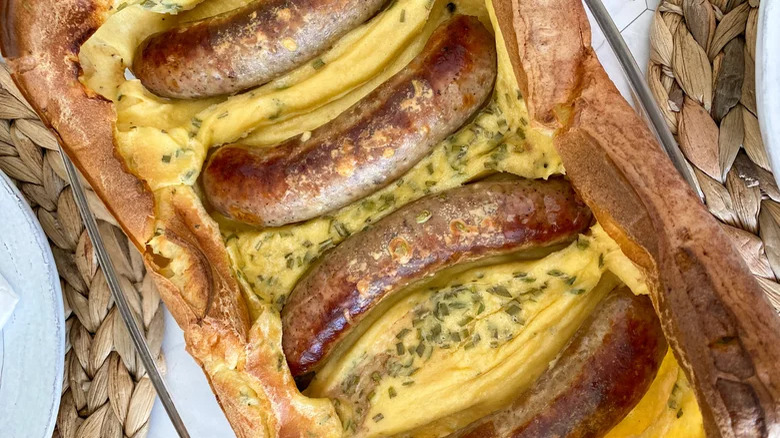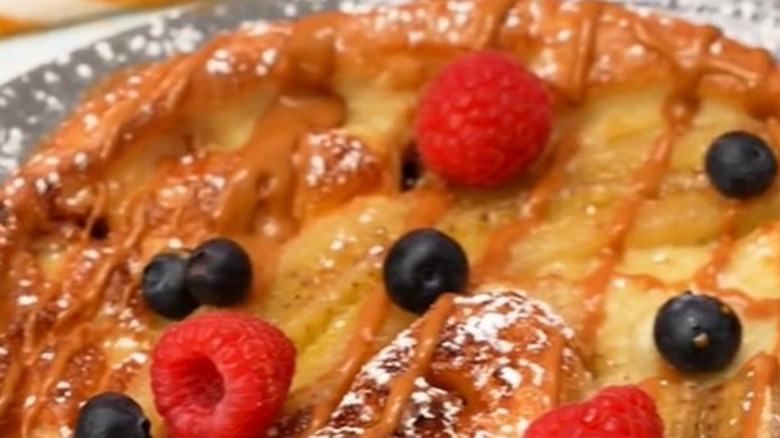Mistakes Everyone Makes With Yorkshire Pudding
It's the weekend, and the whole family is looking forward to a classic ribeye roast. While Americans may overindulge at Thanksgiving, the Brits love a good old-fashioned roast dinner with all the trimmings on Sundays. In addition to preparing meat and veggies, one iconic side that is typically served with any type of roast beef is Yorkshire pudding. Crispy with a slightly doughy center, these savory popover-style treats are lovingly referred to as Yorkies or Yorkshire puds in England.
It might be called pudding, but it is traditionally served with or before the entrée rather than at dessert time. Made from a batter, these light and crispy bites with just the right amount of stodge were certainly a great way to fill up hungry diners. With meat being more expensive, the idea was to have guests fill up on the too-tempting batter cakes before the roast arrived so they would eat less of it. It's almost like eating bread rolls before a meal — the danger is you might ruin your appetite for the main course.
Even though Yorkshire pudding is simple to make –- in theory –- there are so many mistakes that can occur during the process, leaving your meal to fall flat. But don't fret. We're here to help. Here are some common mistakes when it comes to Yorkshire pudding and ways to avoid them.
Adding the wrong amount of flour
The ingredients you need to make Yorkshire puddings aren't complex. You essentially need flour, eggs, and milk plus oil for baking. Some recipes call for a pinch of salt, too. Sounds simple, right? Only if you don't make one of the most basic mistakes so many home cooks make with Yorkshire puddings and get the ratios wrong. Investigate different recipes to find one that suits you, and remember it. One to try is our traditional Yorkshire pudding recipe by whisking a cup of all-purpose flour with 4 eggs, ½ teaspoon of salt, and 1½ cups of whole milk.
If you use too much flour, then your batter will be thicker and result in a heavier pudding. Since you want your Yorkies to rise, it's necessary to ensure the batter is full of air and not too dense. Some recipes call for the amount of flour to match the amount of liquid, in this case the eggs and milk. However, you'll find recipes that call for double the amount of liquid or even more. Some recipes call for more flour. The less flour there is in relation to liquid, the more the pudding will rise. If you don't use enough flour, though, you won't get that contrast of crispy and a little chewy, which is what make a perfect Yorkshire pud.
Not adding the right amount of milk
The milk you add to make a batter is as important as the other ingredients. Add too much, and you may find that your mixture loses its thickness and becomes less like a batter and too watery. Veteran TV chef Mary Berry says she adds only a little milk to the eggs and flour to start, whisking that up before gradually adding the rest of the milk. She also recommends not using full-fat milk. If that's all you have, she suggests mixing it with water to thin it out. The lower fat content in the batter results in the puddings being lighter and rising so that they become lovely and crispy too.
Try this Yorkshire pudding recipe by mixing 2 cups of all-purpose flour with 4 large eggs and ⅔ cup water. When you add a cup of whole milk, do so gradually. You want the liquid to be fully mixed in before you add any more. Keep whisking the batter until the consistency is like heavy cream. It should be thick without being stodgy. You're not making a cake here. Sifting the flour can also make whisking easier and add air into the batter.
Getting the ratio of eggs wrong
No two Yorkshire pudding recipes are the same, and the right one for you depends on how you like them to turn out. TV chef James Martin adds a whopping 8 eggs for every 8 ounces of flour, along with a pint of milk. It's by whisking in the egg that you get lots of air in your final batter too. And this is important if you want your puddings to rise. Get the ratio of eggs wrong, and you're repeating a mistake that plenty of home cooks make. You might decide that keeping everything equal works best.
You can also play around with the amount of egg yolks and egg whites you add. It stands to reason that a batter with more yolks is going to be richer and one with a greater amount of whites will create a lighter pudding. It's probably more important to get the number of whole eggs right rather than focus on separating them. However many eggs you add, the most popular method is to crack the eggs into a well in the flour and whisk these in before adding any milk. You can also beat the eggs first before adding them to the flour.
Creating a lumpy batter
You don't have to be muscly to make a good batter, but you do have to put in a little work. Take out any frustrations with a batter whisking workout. Don't stop until you've whipped it into a smooth and silky mixture. And don't be using a small bowl for this. Grab a large bowl so that the eggs, flour, and milk have room to combine, and you can beat the floury lumps out of it. The best way to do this is with a good-quality balloon whisk.
Whichever order you add the ingredients, the aim is the same: no floury lumps. Another reason for vigorously whisking the batter until it's velvety is to get some air into the mixture. You want your Yorkshire puddings to rise, right? And no, you can't take a shortcut by using your mixer. You need to do this by hand so that the flour doesn't become too tough in the batter. When you think it's good to go, dip a tablespoon into your mix and pull it out. If the batter coats the back of the entire spoon with no lumps, then it's ready.
Not letting the batter rest
If you're cooking up a tender rump roast recipe with all the trimmings, then Yorkshire puddings are an absolute must. Rather than whisk up the batter just before popping the mixture in the oven, plan ahead and make it the night before. You might be making a gourmet family Sunday lunch or a leisurely weekend feast for friends, so you want these crispy treats to rise to the occasion along with the succulent meat. Just as you let the beef rest before serving, you need to make sure your Yorkshire pudding batter rests before baking too. This lets the ingredients meld together properly.
Leave the batter in a jug in the fridge overnight, and just be sure to give it a whisk again when you take it out to get some air into it. If you don't have that much time -– or you forget -– then try and make the batter a good few hours beforehand and refrigerate if you can. While some chefs state that you don't need to rest the mixture at all, the advice from most experts is to do so in order to make the Yorkshire pudding rise more in the oven. It also creates a better taste and texture too. Just be sure to take the mixture out of the fridge so that it's not too cold before it goes into the oven, as that can affect how much the batter rises as well.
Using the wrong oil
A common mistake everyone makes with Yorkshire pudding is not using the right oil. Before you grab whatever oil you have on hand, consider how important this is to one of the essential side dishes for your meal. A good Yorkshire pudding can make a meal, and a bad one can pull down the impressiveness of everything else on the plate. You've been warned.
A good choice might be sunflower oil or vegetable oil, both of which have high smoke points. Other choices might be groundnut oil or sunseed oil. A classic fat to use has always been beef drippings, and you don't need to be a culinary genius to know that this type of fat is going to give your puddings a more intense flavor. The texture of your Yorkies is also affected by the fat you use. Drippings are solid at room temperature because compared to vegetable oil, they are higher in saturated fat. While this might not be the best choice in terms of health and diet, you'll end up with crispier puds. Another choice is to use shortening. You can also use clarified butter, which has a higher smoke point than regular butter.
Not heating up the oil first
Not heating up the oil before adding in the Yorkshire pudding batter is an absolute no-no. While there's a lot of flexibility in terms of how you mix your ingredients together and how long you rest your batter, there's zero choice with this next step if you want fluffy, crispy Yorkies. You need to heat the oil in the muffin tin if you want to avoid a culinary flop. You want to literally see and hear the batter sizzle as it hits the hot oil so if that's not happening, then the oil isn't hot enough.
To get started, preheat your oven to around 370 degrees Fahrenheit. Add two teaspoons of oil to each Yorkshire pudding tin — add less if you're using a muffin tin with smaller cups. Once you've poured the oil into the muffin tins, heat the tray in the oven for 10 minutes or longer. You want that oil smoking before you add the batter. Note that the amount of oil you use may affect how deep the pudding dips in the middle. A lot of oil will pull the center down more so that as the pudding rises, it creates a more distinctive hole, which is great for spooning in lots of gravy from your plate.
Overfilling the tin
You've taken your tray with hot oil out of the oven, and you're now at a critical stage in making the perfect Yorkshire puddings. You need to pour the batter into each tin without overfilling them but with some sense of urgency so the oil doesn't have the chance to cool down too much. The cooking starts before the tray is put back in the oven. As soon as you pour batter into the hot oil, you should see it bubbling up straight away. Pouring the mixture from a jug makes this step a lot easier and quicker.
British celebrity chef Jamie Oliver uses a spoon to catch the batter drips as he pours between the cups. This isn't to prevent the tray from looking messy but instead to make sure there's no batter that's spilled over. If the mixture in a cup comes in contact with some batter outside of it, then this could stop the pudding from rising by anchoring it. This is another reason not to overfill the cups. Not filling to the brim will ensure that as each Yorkie rises, it won't overflow before it's cooked. It simply rises beautifully. Try filling the cups just one third full so that there's plenty of room for the batter to rise without spilling over. Too much batter for each cup can also result in a denser pud, and you're aiming for light and airy.
Not giving them room to rise
When you heat the oil up before adding your batter, use the top shelf of the oven to ensure your oil gets hot. However, you need to think about space, not just timings and heat, when it comes to cooking. A classic mistake many people make with Yorkshire puddings is not leaving enough room in the oven for the puds to rise spectacularly. By setting your tray on a shelf with another one just above it, you're really setting your expectations low.
When you whisk up a good batter, let it rest, and add to hot oil, you've got all the ingredients for a pudding that's going to stand out on any dinner plate as if it's been created in a professional chef's kitchen. So ensure your batter has the room it needs to rise. If you've got a joint of meat roasting in the middle of the oven, then you'll probably want your Yorkies up high rather than underneath to give them a good blast of heat. Look at how high that shelf is, though, and adjust it if you have to so that there's just the right amount of space for all your dishes. Remember, the heat needs to circulate so that the puds rise, but you don't want them hitting the top of the oven.
Opening the oven door too early
You should be able to watch your Yorkshire puddings triumph easily through the glass of your oven door. There's always the temptation to open the door to check, though. Or you might want to take a look at whatever else you're cooking in there. Before you do, stop and consider this common mistake with Yorkshire puddings that's going to stop them from rising to their full glory. Remember, they may look done through the glass, but they might not be. Don't take a peek too early.
Yorkshireman and TV chef James Martin recommends leaving the oven door closed with the heat set at 430 degrees Fahrenheit for 30 minutes. You then open the door a little to let some of the steam out before closing it again, reducing the heat to 390 degrees Fahrenheit, and letting the Yorkshire puddings cook for another 5-10 minutes until golden. This is essential if you want your puddings to rise and turn crispy rather than be deflated and end up a little soft. Each recipe has its own temperature and timings, though. A good guide is to leave the Yorkies in the oven for around 20-25 minutes at 370 degrees Fahrenheit. It's a good idea to have nothing else in the oven while the puddings are in there. Perhaps you can pop in your puds in while your roast is resting.
Not pairing with the right food
A big Yorkshire pudding can turn a normal plate of food into a culinary work of art. Aside from aesthetics, one mistake you could make is not thinking enough about what else you're pairing with your puds. There's no point having a crispy on the outside yet soft on the inside pudding if you're just going to serve it with a low-quality piece of meat or the wrong type of food.
Because Yorkies are made from batter, they are a solid carb side. They go really well with some protein and some veggies. A rich gravy poured over a pudding with some horseradish sauce on the side is so inviting, especially when served with our oven roasted beef tenderloin. This special meaty dish is a total treat with melt-in-the-mouth forkfuls of beef. Food pairing is not only about taste, but it's also about texture. The crunch of the Yorkshire pudding is divine as you cut into the velvety meat. If you want to carve a roast, then prime rib with a herby au jus is an absolute winner at dinner. Or try our standing roast rib recipe, and serve it with a Yorkshire pudding for a gourmet showstopper. Tender roast rump with red wine gravy is perfect with a Yorkshire pudding on the side as well.
Serving Yorkshire puddings plain all the time
Serving Yorkshire puddings plain all the time is a mistake. Inspiring your culinary creativity is the only way to truly appreciate different foods. And with Yorkies, they offer so many more possibilities. Feisty Brit TV chef Gordon Ramsay adds a handful of grated fresh horseradish into the batter to give the puddings a flavor blast that complements a roast ribeye.
Instead of serving puddings with a classic Sunday roast, you could add some cheese and turn them into Yorkshire pudding pizzas or even use them to make a wrap in place of a flour tortilla. Another way to serve Yorkshire puddings in a more dressed up way is to pair them with smoked salmon with dill. Add lemon and freshly grated horseradish to a creamy spread such as sour cream, yogurt, or crème fraiche, and slather onto pieces of Yorkshire puddings before topping with the fish. The flavors create a light dish that celebrates how great Yorkies can taste when elevated with other ingredients.
Not making a meal out of them
If you haven't got a grand roast to cook to perfection, that doesn't mean you've got to forgo your favorite Yorkies. If you love them that much, then it's a mistake not to seek out recipes that put the crispy battered treat in the spotlight. You don't have to look far.
Try our traditional toad in the hole recipe. You'll be pleased to know, no doubt, that toads are not on the ingredient list. Just add ground mustard, rosemary, and thyme into the Yorkshire pudding batter to create a casserole-dish-sized Yorkie. Pour the batter over browned British sausages, which are colloquially called bangers, and bake in the oven. The links will poke out of the pudding when cooked. To elevate the flavor, you can serve this dish with either an onion gravy -– so good –- or a drizzle of syrup. You can arrange the sausages in a spiral to create an appealing design or use a coiled Cumberland sausage too. Even if you're intent on making a roast dinner with all the trimmings, you could serve the meat and vegetables in the center of a giant Yorkshire pudding so it becomes a bigger part of the meal.
Forgetting they can be sweet
There are plenty of ingredients and meals that are appetizing whether served as a sweet or a savory dish. A mistake everyone makes with Yorkshire puddings — and this includes Brits who should know better -– is to only serve them as an entrée. "The Great British Bake Off" TV show winner Nadiya Hussain showcases a sweet version in her cookbook "British Food Adventure." She presents Yorkshire puddings with jam and custard.
TikTok poster @thisisplanetfood demonstrates how to make a sweet version of toad in the hole. Instead of sausages, you add bananas halved lengthways, along with brown sugar and caramel bits. Once cooked, dust your Yorkie with powdered sugar and drizzle with Biscoff cookie butter. Sprinkle on some fresh raspberries and blueberries. You can also air fry ready-made Yorkshire puddings, fill them with crushed raspberries and melted chocolate, then top with mini chocolate eggs. You can also keep it simple as many families do in England, and enjoy a Yorkie with a sprinkling of sugar served after a big roast.
